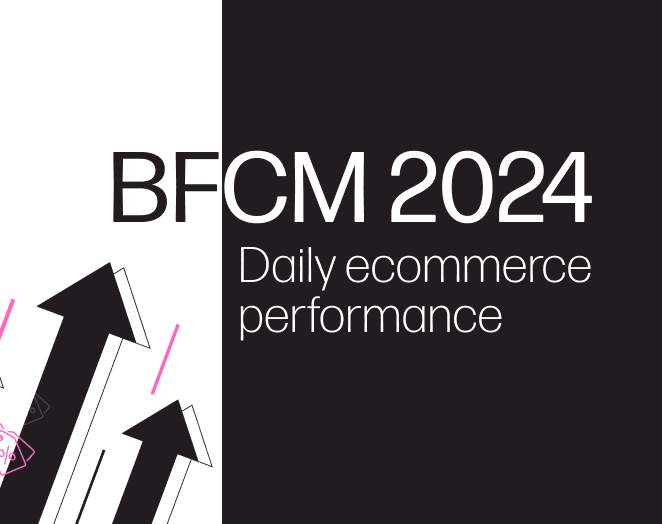Research: Predicted impact of ecommerce search on Black Friday Cyber Monday 2023 performance
As the hotly-awaited Black Friday Cyber Monday (BFCM) weekend of 2023 draws near, we take a look at the significance that ecommerce search will have in shaping performance. Integrating our 2023 search research with third-party projections on BFCM 2023 performance, we highlight what’s at stake for ecommerce if retailers don’t improve their site search—and stress four key areas they should look towards in preventing this.
Retailers risk losing $13.8 bn in sales due to poor search
As part of our proprietary research that we conducted this year, The Future of Ecommmerce Search, we investigated consumer sentiment around ecommerce search, surveying 1000 North American consumers.
We uncovered significant findings, not least of which was how, while 77% of NA shoppers go straight to the search bar when landing on an ecommerce store, 84% then leave because their search experience is subpar. That’s a significant percentage of high-intent traffic leaving online stores due to poor search, and with BFCM coming up (when traffic’s at an all-time high) merchants risk leaving a lot on the table. To put this into perspective, we’ve reviewed these statistics alongside projected performance for BFCM 2023 and calculated exactly how much is at stake.
Projected ecommerce expenditure for BFCM 2023 stands at $21.36 (1) billion and the average order value at $108 (2)—which would equate to 198 million separate transactions.
If we extrapolate the findings of our search research and assume that 77% of those potential transactions are shoppers who head straight to the search bar, and 88% then bounce, retailers would lose a whopping $13.8 billion in sales because of poor search alone.(3)
It’s a terrifying amount, but there’s still time to prevent this.
Four key search failings are likely to make shoppers bounce this BFCM
With $13.8 billion in potential sales at risk due to inadequate search functions, we’ve highlighted which specific areas of site search merchants should focus on improving to reduce their losses. This is based on what consumers told us in our survey are aspects of site search that are likely to make them bounce.

While these 4 aspects of site search are most likely to make shoppers bounce, the good news is: most of these are easily solved. Here are some suggestions to counter some of the above:
- Improve your search results’ relevancy by having simple search functionalities such as error tolerance that you might be overlooking; Our research suggests that 76% of brands don’t have error tolerance!
- Even if you don’t have relevant results to display, try offering alternative products to continue the product discovery journey; A significant 60% of shoppers in our research said they would continue shopping on an online store if alternative products were suggested upon 0 results.
- If your brand has a large product catalog, help shoppers navigate this by providing useful contextual filters based on their search queries to help them narrow down results. For example, have an ‘occasion’ filter for dresses to help people look specifically for ‘evening’ or ‘wedding’ dresses.
- Be cautious listing out-of-stock items in search results. Integrate your site search with inventory systems to ensure it is dynamically updated with product stock levels, and try weighting your merchandising around your inventory.
Including content within search results will be beneficial
As well as fixing the key aspects of site search that cause shoppers to bounce, our research suggests that brands should incorporate content into their search results.
Nearly two-thirds (66%) of consumers in our survey said they’d engage with relevant content in search results (which can be anything from FAQ pages to collection pages). Meanwhile, 64% said they’re likely to buy products having engaged with such content—demonstrating how influential this can be on purchase decisions.
Visual user-generated content (UGC) is also fruitful when it comes to site search. For instance, we found that 58% of consumers engage with relevant UGC within search results, and 64% are likely to purchase after engaging with it. Moreover, the social proof that UGC brings is especially important in winning customers as the rises in living costs have meant that 75% of shoppers are more frequently comparing products across multiple stores.

Search is crucial in engaging young millennials
When we look at the demographic splits of our consumer survey, we find that search is a particularly important part of young millennials’ (25–34-year-olds) site experience. 83% of young millennials go straight to the search bar when landing on a site and they’re more likely than any other age group to purchase a product directly that they’ve searched for (90%). However, the same number (90%) say they often come across irrelevant results from searches (against an average of 65%).
Moreover, 90% of young millennials agree that a good, fast, accurate site search makes online shopping easier. And young millennials—being keen shoppers, tech-savvy, and time-conscious—expect brands to meet their needs.
Amongst 25–34-year-olds, 81% of them believe that site search should be quicker (against an overall average of 62% and just 52% of those who are 55+). Furthermore, as the cost of living increases, 87% of young millennials would like to compare products from different online stores and agree that a good ecommerce search makes this easier (compared to an average of 75% across all ages).
Young millennials also have higher engagement with relevant content such as articles and FAQ pages served on search pages (83% compared all ages with an average of 66%) and are more likely to purchase based on relevant content (83% but only 65% average across all ages).
This pattern of engagement continues into influencer and user-generated content, with over 80% engaging and then purchasing when this type of content is incorporated into search results (83% and 82% respectively).
Merchants targeting young millennials should pay extra attention to their site search experience, as our research evidences just how important search is for this demographic. Furthermore, the fact this demographic is likely to spend more than other generations during the festive season(4) stresses the importance of appealing to this age group ahead of peak season, all the more.
Consumers want relevant and personalized site search experiences
Ultimately, what emerges as the most important aspect of site search merchants need to deliver on is relevancy. When consumers were asked what brands could do to improve search experiences, having more relevant results was chosen by nearly half of the respondents (48%).
Despite 84% of consumers saying they have exited a website because of poor-performing search, a shocking 99% of brands that we surveyed (as part of our broader study) believe that their search results are relevant. This fundamental gap between what consumers want from site search and what brands think they’re delivering will inevitably cause a loss of sales during BFCM unless merchants address their site search problems.
Over two-thirds (77%) of consumers agreed that they are more likely to complete a purchase if their search results are personalized based on things like their purchase history, size preference, and other personal data. For young millennials, this is even more important, with an overwhelming 89% agreeing they are.

It’s not just the search results that consumers want personalized, either. They want merchants to use their search behavior to personalize the rest of the shopper journey from thereon. For instance, our data shows that two-thirds (66%) of consumers want retailers to use the data they gather from their search queries to personalize shoppers’ wider site experience thereafter. With site search being a key place for capturing high-intent data, this can be especially lucrative for merchants in tailoring experiences so closely around intent.
Conclusion
With $13.8 bn hanging in the balance during BFCM weekend, brands need to act now to ensure their potential customers don’t bounce due to poor—and mostly quite basic—search failings.
Ultimately, you want to ensure your shoppers’ search experiences are fast, relevant, personalized, easy to navigate, and supplemented by content (especially those of you targeting young millennials!).
To find out if your site search is up to scratch ahead of peak and season, get in touch.
And, for the full report of our 2023 research into ecommerce site search that we’ve cited throughout this article, head here.
Footnotes:
- Adobe Analytics 2022 data on Black Friday and Cyber Monday sales and growth rates in the US,
- Based on projecting the 2022 order values from Salesforce quoted in ROIRevolution
- Based on the following calculations:
77% of 198 million = 152460000
84% of 152460000 = 128066400
128066400 x $108 = $13.8bn - Millennials dominate spending amid uncertain economic outlook, PwC




